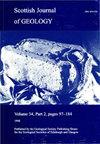堤坝作为变质叠加的物理缓冲:以苏格兰西北部太古代-古元古代路易世片麻岩杂岩为例
IF 1.3
4区 地球科学
Q4 GEOLOGY
引用次数: 3
摘要
多变质基底片麻岩杂岩的早期历史往往由于后期变形和变质事件的套印而难以破译。本文综合了苏格兰西北部刘易斯片麻岩杂岩中一个古元古代基性岩脉中的太古宙调性片麻岩捕虏体的野外、岩石学和矿物化学数据,揭示了岩脉中的捕虏体如何保存早期构造热事件的特征。刘氏片麻岩杂岩的太古代闪长岩-闪长岩-花岗闪长岩(TTG)片麻岩是由古元古代(约2400 Ma)基性岩脉(Scourie岩脉群)切割而成,并在上绿片岩-下角闪岩相拉克弗德事件(1740 - 1670 Ma)期间发育了剪切带。详细的野外填图、岩石学分析和矿物化学分析表明,在拉克斯弗德剪切带中,一条被夹带的TTG片麻岩捕虏体受到了防止角闪岩相再结晶的保护。而周围的TTG片麻岩则表现出普遍的角闪岩相退退,捕虏体则保留了前scourie岩脉、斜辉石质变质组合和片麻岩层状。我们认为,回溯性反应软化和先前存在的软弱面,如c. 2490 Ma因弗里亚构造和片麻岩岩脉接触,将应变定位在捕虏体周围,而不是捕虏体内部。这种应变局部化可以为流体产生优先的流动路径,主要沿着剪切带,绕过捕虏体,保护其免受角闪岩相退变的影响。在基底片麻岩杂岩中,早期变质组合和组构被构造热事件完全覆盖,我们的研究结果表明,基性岩脉中的乡村岩石包体可以保存这些复杂多变质区早期演化的窗口。补充材料:电子探针分析和分析点位置可在:https://doi.org/10.6084/m9.figshare.c.3809545本文章由计算机程序翻译,如有差异,请以英文原文为准。
Dykes as physical buffers to metamorphic overprinting: an example from the Archaean–Palaeoproterozoic Lewisian Gneiss Complex of NW Scotland
The early history of polymetamorphic basement gneiss complexes is often difficult to decipher due to overprinting by later deformation and metamorphic events. In this paper we integrate field, petrographic and mineral chemistry data from an Archaean tonalitic gneiss xenolith, hosted within a Palaeoproterozoic mafic dyke in the Lewisian Gneiss Complex of NW Scotland to show how xenoliths in dykes may preserve signatures of early tectonothermal events. The Archaean tonalite–trondhjemite–granodiorite (TTG) gneisses of the Lewisian Gneiss Complex are cut by a suite of Palaeoproterozoic (c. 2400 Ma) mafic dykes, the Scourie Dyke Swarm, and both are deformed by later shear zones developed during the upper greenschist- to lower amphibolite-facies Laxfordian event (1740 – 1670 Ma). Detailed field mapping, petrographic analysis and mineral chemistry reveal that a xenolith of TTG gneiss entrained within a Scourie dyke has been protected from amphibolite-facies recrystallization in a Laxfordian shear zone. Whereas the surrounding TTG gneiss displays pervasive amphibolite-facies retrogression, the xenolith retains a pre-Scourie dyke, clinopyroxene-bearing metamorphic assemblage and gneissic layering. We suggest that retrogressive reaction softening and pre-existing planes of weakness, such as the c. 2490 Ma Inverian fabric and gneiss–dyke contacts, localized strain around but not within the xenolith. Such strain localization could generate preferential flow pathways for fluids, principally along the shear zone, bypassing the xenolith and protecting it from amphibolite-facies retrogression. In basement gneiss complexes where early metamorphic assemblages and fabrics have been fully overprinted by tectonothermal events, our results suggest that country rock xenoliths in mafic dykes could preserve windows into the early evolution of these complex polymetamorphic areas. Supplementary material: Electron microprobe analyses and analytical spot locations are available at: https://doi.org/10.6084/m9.figshare.c.3809545
求助全文
通过发布文献求助,成功后即可免费获取论文全文。
去求助
来源期刊

Scottish Journal of Geology
地学-地质学
CiteScore
1.70
自引率
0.00%
发文量
10
审稿时长
>12 weeks
期刊介绍:
Although published only since 1965, the Scottish Journal of Geology has a long pedigree. It is the joint publication of the Geological Society of Glasgow and the Edinburgh Geological Society, which prior to 1965 published separate Transactions: from 1860 in the case of Glasgow and 1863 for Edinburgh.
Traditionally, the Journal has acted as the focus for papers on all aspects of Scottish geology and its contiguous areas, including the surrounding seas. The publication policy has always been outward looking, with the Editors encouraging review papers and papers on broader aspects of the Earth sciences that cannot be discussed solely in terms of Scottish geology.
The diverse geology of Scotland continues to provide an important natural laboratory for the study of earth sciences; many seminal studies in geology have been carried out on Scottish rocks, and over the years the results of much of this work had been published in the Journal and its predecessors.
The Journal fully deserves its high reputation worldwide and intends to maintain its status in the front rank of publications in the Earth sciences.
 求助内容:
求助内容: 应助结果提醒方式:
应助结果提醒方式:


